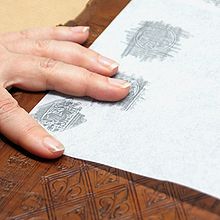Rubbing (art): Difference between revisions
Appearance
Content deleted Content added
No edit summary Tags: Mobile edit Mobile web edit |
SoAnactoria (talk | contribs) Added two references (NYT article, article from the MoMA about the frottage technique.) Fixed a typo from "Rubing" to "Rubbing." Linked "frottage" in the first sentence to the Wiki page for it. |
||
| Line 5: | Line 5: | ||
[[File:Einbanddurchreibung von Stempeln (0117).jpg|thumb|A rubbing of portions of a book cover]] |
[[File:Einbanddurchreibung von Stempeln (0117).jpg|thumb|A rubbing of portions of a book cover]] |
||
[[File:Gnidebillede Genstande 0263.jpg|thumb|Rubbing of Icelandic woodcuts]] |
[[File:Gnidebillede Genstande 0263.jpg|thumb|Rubbing of Icelandic woodcuts]] |
||
A ''' |
A '''rubbing''' (''[[Frottage (art)|frottage]]'') is a reproduction of the [[Surface finish|texture]] of a surface created by placing a piece of paper or similar material over the subject and then rubbing the paper with something to deposit marks, most commonly [[charcoal]] or [[pencil]] but also various forms of blotted and rolled ink, [[chalk]], [[wax]], and many other substances.<ref>{{Cite web |title=Frottage {{!}} MoMA |url=https://www.moma.org/collection/terms/frottage |access-date=2022-12-11 |website=The Museum of Modern Art |language=en}}</ref> For all its simplicity, the technique can be used to produce blur-free images of minuscule elevations and depressions on areas of any size in a way that can hardly be matched by even the most elaborate, state-of-the-art methods. In this way, surface elevations measuring only a few thousandths of a millimeter can be made visible.<ref>Lukowsky, D., ''Failure Analysis of Wood and Wood-Based Products'', McGraw-Hill Education; 1st edition (2015) {{ISBN|978-0-07-183937-2}}.</ref> |
||
Common uses for this technique include: |
Common uses for this technique include: |
||
| Line 11: | Line 11: | ||
* [[Forensic]] uses, including finding out what was written on a sheet of paper removed from a pad by rubbing the impressions left on subsequent sheets or other backing materials |
* [[Forensic]] uses, including finding out what was written on a sheet of paper removed from a pad by rubbing the impressions left on subsequent sheets or other backing materials |
||
* [[Frottage (art)|Frottage]], a [[surrealist]] art form |
* [[Frottage (art)|Frottage]], a [[surrealist]] art form |
||
* [[Stone rubbing]], to make copies of patterns and inscriptions of gravestones or other incised or textured stone surfaces |
* [[Stone rubbing]], to make copies of patterns and inscriptions of gravestones or other incised or textured stone surfaces<ref>{{Cite news |last=Smaridge |first=Norah |date=1975-07-27 |title=Tombstones, Manhole Covers and The Ancient Art of Rubbing |language=en-US |work=The New York Times |url=https://www.nytimes.com/1975/07/27/archives/tombstones-manhole-covers-and-the-ancient-art-of-rubbing-the.html |access-date=2022-12-11 |issn=0362-4331}}</ref> |
||
==References== |
==References== |
||
Revision as of 19:13, 11 December 2022
This article needs additional citations for verification. (July 2019) |


A rubbing (frottage) is a reproduction of the texture of a surface created by placing a piece of paper or similar material over the subject and then rubbing the paper with something to deposit marks, most commonly charcoal or pencil but also various forms of blotted and rolled ink, chalk, wax, and many other substances.[1] For all its simplicity, the technique can be used to produce blur-free images of minuscule elevations and depressions on areas of any size in a way that can hardly be matched by even the most elaborate, state-of-the-art methods. In this way, surface elevations measuring only a few thousandths of a millimeter can be made visible.[2]
Common uses for this technique include:
- Brass rubbing, to make copies of monumental brasses
- Forensic uses, including finding out what was written on a sheet of paper removed from a pad by rubbing the impressions left on subsequent sheets or other backing materials
- Frottage, a surrealist art form
- Stone rubbing, to make copies of patterns and inscriptions of gravestones or other incised or textured stone surfaces[3]
References
- ^ "Frottage | MoMA". The Museum of Modern Art. Retrieved 2022-12-11.
- ^ Lukowsky, D., Failure Analysis of Wood and Wood-Based Products, McGraw-Hill Education; 1st edition (2015) ISBN 978-0-07-183937-2.
- ^ Smaridge, Norah (1975-07-27). "Tombstones, Manhole Covers and The Ancient Art of Rubbing". The New York Times. ISSN 0362-4331. Retrieved 2022-12-11.
External links
Wikimedia Commons has media related to Rubbings or tripsigraphs.
